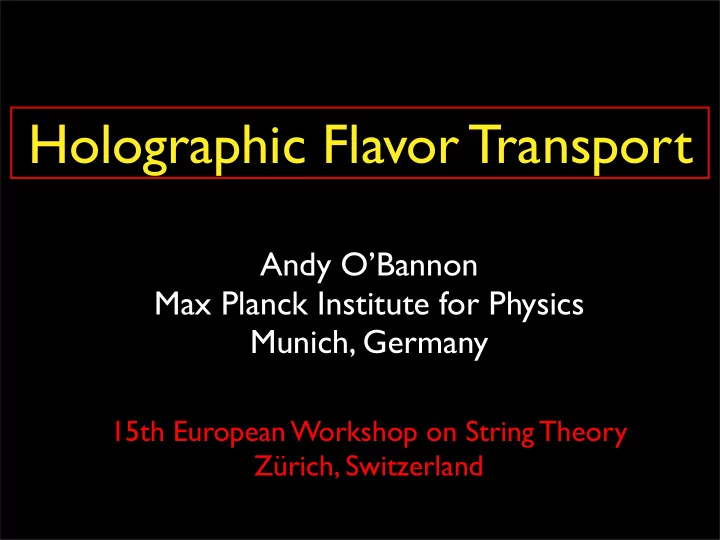

Holographic Flavor Transport Andy O’Bannon Max Planck Institute for Physics Munich, Germany 15th European Workshop on String Theory Zürich, Switzerland
Credits • 0705.3870 A. Karch and A. O’B. • 0708.1994 A. O’B. • 0808.1115 A. O’B. • 0812.3629 A. Karch, A. O’B., E. Thompson • 0908.2625 M. Ammon, H.T. Ngo, A. O’B.
Outline: • I. Motivation • II. The System • III. The Conductivity • IV. Summary and Outlook
I. Motivation REAL Strongly-coupled Systems Quantum Chromodynamics (QCD) Relativistic Heavy-Ion Collider (RHIC) T ≤ 2 × T c QCD at T c ≈ 170 MeV Strongly-coupled, Nearly-ideal FLUID
Question: Can we compute TRANSPORT COEFFICIENTS for QCD at RHIC temperatures?
Question: Can we compute TRANSPORT COEFFICIENTS for QCD at RHIC temperatures? Answer: NO.
Philosophy: CHANGE the Question Question: Can we find ANY STRONGLY-COUPLED system for which we CAN compute TRANSPORT COEFFICIENTS?
Answer: YES! N = 4 supersymmetric SU(N c ) Yang-Mills (SYM)
Use Gauge-gravity Duality Shear Viscosity ⎯
GOAL Compute a CONDUCTIVITY associated with “Quarks” or “Electrons” using Gauge-gravity Duality
RESULT 2 N c 2 d 2 N f e 2 + 1 f ( m ) + σ = 16 π 2 T 2 e 2 + 1 Current nonlinear in E Pair Production Drude Conductivity
Outline: • I. Motivation • II. The System • III. The Conductivity • IV. Summary and Outlook
II. The System N = 4 supersymmetric SU(N c ) Yang-Mills (SYM) β = 0
II. The System N = 4 supersymmetric SU(N c ) Yang-Mills (SYM) No Quarks!
ADD N f N = 2 hypermultiplets ⎛ ⎞ β = + Ο N f ⎜ ⎟ ⎝ ⎠ N c “Probe Limit’’ << fixed
Scales Temperature Mass J μ symmetry current Baryon Number Density
Electric Field “Two-fluid” picture Lorentz force = Drag Force
⇒ ⇒ Steady-state??? Momentum Translation Invariance Conservation Net Charge Net Work + Constant Electric Field ENTIRE SYSTEM ACCELERATES FOREVER NO DISSIPATION!
Probe Limit MIMICS Dissipation T µ ν = Ο ( N c 2 ) µ ν + Ο ( N f N c ) µ ν ∂ µ T µ ν = F νσ J σ ∂ t T tx = − E J t ∂ t T tt = E J x E = Ο (1) J µ = Ο ( N f N c )
Holographic Dual Supergravity N = 4 SYM = = Finite temperature AdS-Schwarzschild N f probe D7-branes N f N = 2 hypers. = AdS 5 × S 3 m = Embedding J µ A µ =
The Method ∫ S D 7 = − N f T D 7 d 8 x − det( g ab + (2 πα ') F ab ) • NOT Kubo formula! • Compute 1-pt. function DIRECTLY • Exploit Born-Infeld dynamics with E field • Valid for any Dp/Dq system
Outline: • I. Motivation • II. The System • III. The Conductivity • IV. Summary and Outlook
III. The Conductivity 2 N c 2 d 2 N f e 2 + 1 f ( m ) + σ = 16 π 2 T 2 e 2 + 1 E J t e = d = π π λ T 2 λ T 2 2 2
III. The Conductivity 2 N c 2 d 2 N f e 2 + 1 f ( m ) + σ = 16 π 2 T 2 e 2 + 1 Depends on E! J x = σ ( E ) E J x = σ (0) E Linearize in E
III. The Conductivity 2 N c 2 d 2 N f e 2 + 1 f ( m ) + σ = 16 π 2 T 2 e 2 + 1 J t = 0 σ ≠ 0 BUT Pair Production
III. The Conductivity 2 N c 2 d 2 N f e 2 + 1 f ( m ) + σ = 16 π 2 T 2 e 2 + 1 m → ∞ f ( m ) → 0 ⇒ f ( m ) → 1 m → 0 ⇒
III. The Conductivity 2 N c 2 d 2 N f e 2 + 1 f ( m ) + σ = 16 π 2 T 2 e 2 + 1 T tx ∝ J t NO momentum flow at zero density
III. The Conductivity 2 N c 2 d 2 N f e 2 + 1 f ( m ) + σ = 16 π 2 T 2 e 2 + 1 Drude Conductivity m → ∞ Linearize in E σ (0) Take J t σ → d = π λ T 2 2
Why m → ∞ ? Charges behave as semi-classical quasi-particles: dp dt = − µ p + E Separate calculation µ m = π λ T 2 2
µ m = π λ T 2 2 J t J t σ → d = λ T 2 = π µ m 2 Drude Conductivity
Outline: • I. Motivation • II. The System • III. The Conductivity • IV. Summary and Outlook
IV. Summary + Outlook Probe Branes are Great! Computed CONDUCTIVITY for a “DISSIPATIVE” STRONGLY-COUPLED Non-Abelian Gauge Theory
FUTURE DIRECTIONS MORE TRANSPORT COEFFICIENTS: Magnetic Fields Anomalous currents Condensed Matter Applications: Thermo-electric Transport Quantum Hall Effect Superfluidity Non-relativistic Theories
Thank You.
Recommend
More recommend